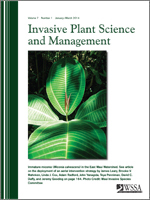The miconia (Miconia calvescens) invasion of the East Maui Watershed (EMW) started from a single introduction over 40 yr ago, establishing a nascent patch network spread across 20,000 ha. In 2012, an accelerated intervention strategy was implemented utilizing the Herbicide Ballistic Technology (HBT) platform in a Hughes 500D helicopter to reduce target densities of seven nascent patches in the EMW. In a 14-mo period, a total of 48 interventions eliminated 4,029 miconia targets, with an estimated 33% increase in operations and 168% increase in recorded targets relative to the adjusted means from 2005 to 2011 data (prior to HBT adoption). This sequence of interventions covered a total net area of 1,138 ha, creating a field mosaic of overlapping search coverage (saturation) for each patch (four to eight interventions per patch). Target density reduction for each patch fit exponential decay functions (R2 > 0.88, P < 0.05), with a majority of the target interventions spatially assigned to the highest saturation fields. The progressive decay in target density led to concomitant reductions in search efficiency (min ha−1) and herbicide use rate (grams ae ha−1) in subsequent interventions. Mean detection efficacy (± SE) between overlapping interventions (n = 41) was 0.62 ± 0.03, matching closely with the probability of detection for a random search operation and verifying imperfect (albeit precise) detection. The HBT platform increases the value of aerial surveillance operations with 98% efficacy in target elimination. Applying coverage saturation with an accelerated intervention schedule to known patch locations is an adaptive process for compensating imperfect detection and building intelligence with spatial and temporal relevance to the next operation.
Nomenclature: Miconia, Miconia calvescens DC.
Management Implications: The herbicide ballistic technology (HBT) platform is a herbicide delivery system registered as a 24(c) Special Local Need for use in Hawaii to treat nascent satellite miconia patches in remote natural areas that require helicopter operations. We define an intervention as a weed management operation with the combined actions of target detection immediately followed by effective elimination. In 14 mo, a total of 48 interventions were conducted for seven nascent patches, (1) eliminating 4,029 miconia targets and (2) encompassing a total net area of 1,138 ha, while (3) administering < 1% of the maximum allowable herbicide use rate. Target density reduction for the patch network was > 86%, fitting an exponential decay function. This resulted in a threefold improvement in search efficiency (min ha−1) and a 10-fold reduction in herbicide use rate (g ae ha−1). Expansion of the total net area corresponded to improvements in search efficiency; less time was needed to saturate known target locations with reduced densities. These interventions are described as random search operations with imperfect detection. Efficacy of an HBT application to miconia can be confirmed in less than 1 mo, allowing for the acceleration of intervention schedules that can compensate for imperfect detection by saturating coverage with compounding sequential interventions. The goals of this accelerated intervention strategy are to rapidly reduce nascent patch populations to manageable or undetectable levels and build spatially and temporally explicit intelligence, where expected projections are accurate with observed values.





